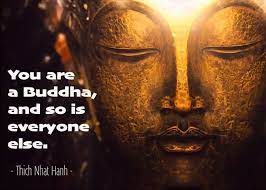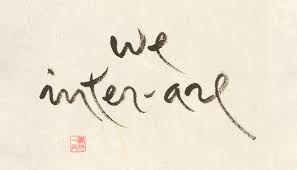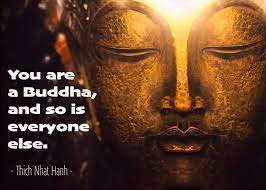Beoefening van Sangha: Vriendschap
Practicing in a Sangha: FriendshipMeditatie en uitwisseling in "de Schatkamer"
Maandag 28 Oktober, 2024 (English below)
Dierbare Sangha,
De afgelopen weken hebben we onderzocht wat Sangha voor ons betekent.
Als ik mijn samenvatting mag delen: We bestuderen samen de Dharma en oefenen we om die toe te passen en er is een sfeer van:
Aandacht, Openheid, Inclusiviteit, Vertrouwen en Vreedzaamheid.
We bieden elkaar veiligheid om te ontspannen en te openen.
Het belang van samen herken ik in momenten waarin je soms zelf verstrikt kunt raken in "gedachten treintjes" die rondjes rijden in je mind. Of waar je verstrikt raakt in emoties en daarmee geen helder zicht meer hebt op een situatie.
De Sangha heeft me steeds een veilige omgeving geboden om te openen en te onderzoeken.
Een ander kado dat ik ontvang van Sangha is toetssteen en klankbord: Hoe zie jij dat?, Kijk eens mee? Heb ik het goed begrepen als ..?
Voor dieper begrip van de Dharma zoek ik voeding bij een leraar, maar de Sangha broers en zusters zijn altijd dichtbij.
Thich Nhat Hanh heeft een prachtige Sutra vertaald en toegelicht:
"The better way to catch a snake" over hoe we vaak zelf een uitleg geven, maar niet door hebben dat het een schadelijke interpretatie is.
We kunnen elkaar steunen en voeden op ons pad.
Het gevoel van inter-zijn, openheid en vriendschap wordt prachtig verwoord in een lied dat vaak gezongen wordt in de PlumVillage gemeenschap:
I am a cloud, I am the blue sky,
I am a bird spreading out ít wings,
I am a flower, I am the sunshine,
I am the earth, receiving a seed.
Re:
And I am free, when my heart is open,
Yes I am free, when my mind is clear,
Oh dear brother, Oh dear sister,
Let’s walk together, mindfully. (2x)
In een van de Sutra's corrigeert de Boeddha zijn assistent Ananda, die vriendschap de helft van het spirituele leven noemde:
"Zeg dat niet Ananda !, Vriendschap en kameraadschap is het hele spirituele leven!"
We zullen samen mediteren en delen over inter-zijn en vriendschap
Het voorstel voor een oefening voor deze week is:
"Hoe kunnen we elkaar steunen en voeden."
Ik wens ons een prachtig weekend vol ontdekking en verbinding.
Warme groeten
Hans
Maandag 28 Oktober, 2024 (English below)
Dierbare Sangha,
De afgelopen weken hebben we onderzocht wat Sangha voor ons betekent.
Als ik mijn samenvatting mag delen: We bestuderen samen de Dharma en oefenen we om die toe te passen en er is een sfeer van:
Aandacht, Openheid, Inclusiviteit, Vertrouwen en Vreedzaamheid.
We bieden elkaar veiligheid om te ontspannen en te openen.
Het belang van samen herken ik in momenten waarin je soms zelf verstrikt kunt raken in "gedachten treintjes" die rondjes rijden in je mind. Of waar je verstrikt raakt in emoties en daarmee geen helder zicht meer hebt op een situatie.
De Sangha heeft me steeds een veilige omgeving geboden om te openen en te onderzoeken.
Een ander kado dat ik ontvang van Sangha is toetssteen en klankbord: Hoe zie jij dat?, Kijk eens mee? Heb ik het goed begrepen als ..?
Voor dieper begrip van de Dharma zoek ik voeding bij een leraar, maar de Sangha broers en zusters zijn altijd dichtbij.
Thich Nhat Hanh heeft een prachtige Sutra vertaald en toegelicht:
"The better way to catch a snake" over hoe we vaak zelf een uitleg geven, maar niet door hebben dat het een schadelijke interpretatie is.
We kunnen elkaar steunen en voeden op ons pad.
Het gevoel van inter-zijn, openheid en vriendschap wordt prachtig verwoord in een lied dat vaak gezongen wordt in de PlumVillage gemeenschap:
I am a cloud, I am the blue sky,
I am a bird spreading out ít wings,
I am a flower, I am the sunshine,
I am the earth, receiving a seed.
Re:
And I am free, when my heart is open,
Yes I am free, when my mind is clear,
Oh dear brother, Oh dear sister,
Let’s walk together, mindfully. (2x)
In een van de Sutra's corrigeert de Boeddha zijn assistent Ananda, die vriendschap de helft van het spirituele leven noemde:
"Zeg dat niet Ananda !, Vriendschap en kameraadschap is het hele spirituele leven!"
We zullen samen mediteren en delen over inter-zijn en vriendschap
Het voorstel voor een oefening voor deze week is:
"Hoe kunnen we elkaar steunen en voeden."
Ik wens ons een prachtig weekend vol ontdekking en verbinding.
Warme groeten
Hans
19:15: voorbereiden van de ruimte
19.30: aankomen, thee en ontmoeting
20h00 Inleiding thema, geleide meditatie, loopmeditatie,
stille meditatie.
ca 21h00. dharma-sharing
ca 21h30 afsluiting en opruimen
Samen thee drinken en persoonlijk contact voor wie wil
ankondiging:
op 1 november is er een studiedag over de Realiteit en onze belevingswereld.
Daar zullen spreken: Han de Wit, Anne-Miek Vroom, Cuong Lu, Dan Lusthaus
Meer informatie vind je op:
https://www.mindonly.nl/conferentie/conferentie-2024
Voor studenten is er gereduceerd tarief, zo ook voor als je iemand mee neemt
op 1 november is er een studiedag over de Realiteit en onze belevingswereld.
Daar zullen spreken: Han de Wit, Anne-Miek Vroom, Cuong Lu, Dan Lusthaus
Meer informatie vind je op:
https://www.mindonly.nl/conferentie/conferentie-2024
Voor studenten is er gereduceerd tarief, zo ook voor als je iemand mee neemt
Practicing in a Sangha: Friendship
Meditation and sharing in "de Schatkamer" this Monday evening.
Dear Sangha,
The past weeks we have been investigating what Sangha means to us.
If I may share my summary:
We study and practice to apply the Dharma together and our Sangha has a mindset of mindfulness, openness, inclusiveness, trust and peacefulness.
We offer a safe space for us to relax and open-up.
The importance of together, I recognize in moments in which I am sometimes caught in "thought trains that run in loops" Or when I can be trapped in emotions that impede clear view on the situation.
The Sangha always offered me a safe environment to open-up and investigate.
Another present I received in the Sangha is a mirror and a sounding board: How do you see this?, Have I understood it correctly if ...?
For deeper understanding I seek guidance and nourishment with a teacher, but on a daily basis the Sangha brothers and sisters are near.
Thich Nhat Hanh has translated and commented on a beautiful sutra:
"The better way to catch a snake" about how we often are convinced that we have an understanding, but do not recognize that it is a harmful interpretation.
We can support and nourish each other on our path.
The feeling of inter-being, openness and friendship is beautifully expressed in a song that is often sung in the PlumVillage community:
I am a cloud, I am the blue sky,
I am a bird spreading out ít wings,
I am a flower, I am the sunshine,
I am the earth, receiving a seed.
Re:
And I am free, when my heart is open,
Yes I am free, when my mind is clear,
Oh dear brother, Oh dear sister,
Let’s walk together, mindfully. (2x)
In one of the Sutra's Buddha is correcting his attendant Ananda, who called friendship half of the spiritual life.
"Don't say that Ananda, Good Friendship and Good Comradeship is the whole of the spiritual life"
We will meditate and share together about inter-being and friendship,
and the proposal to practice is:
"How can we support and nourish each other"
Have a wonderful weekend full of discovery and connectedness
Warm greetings
Hans










